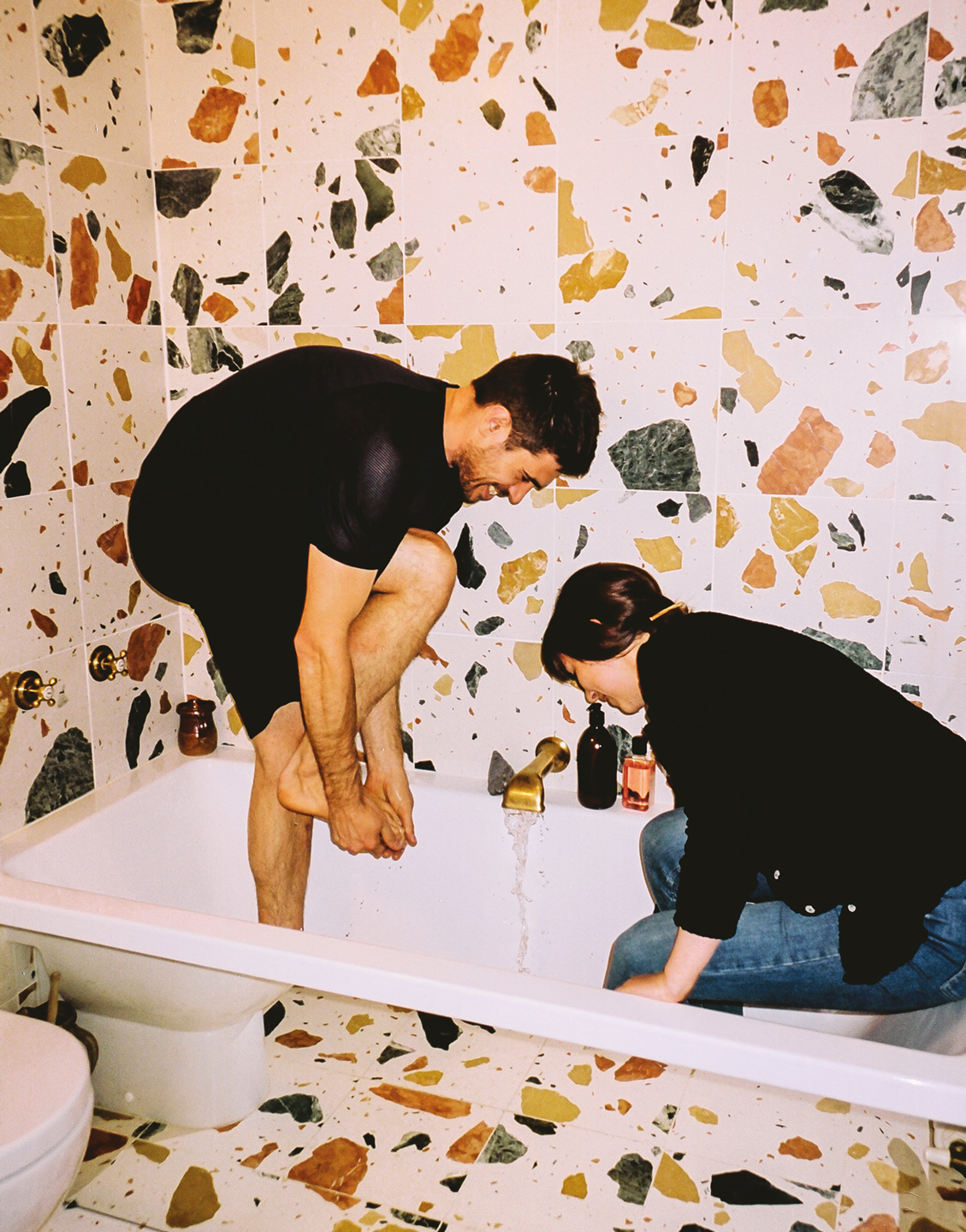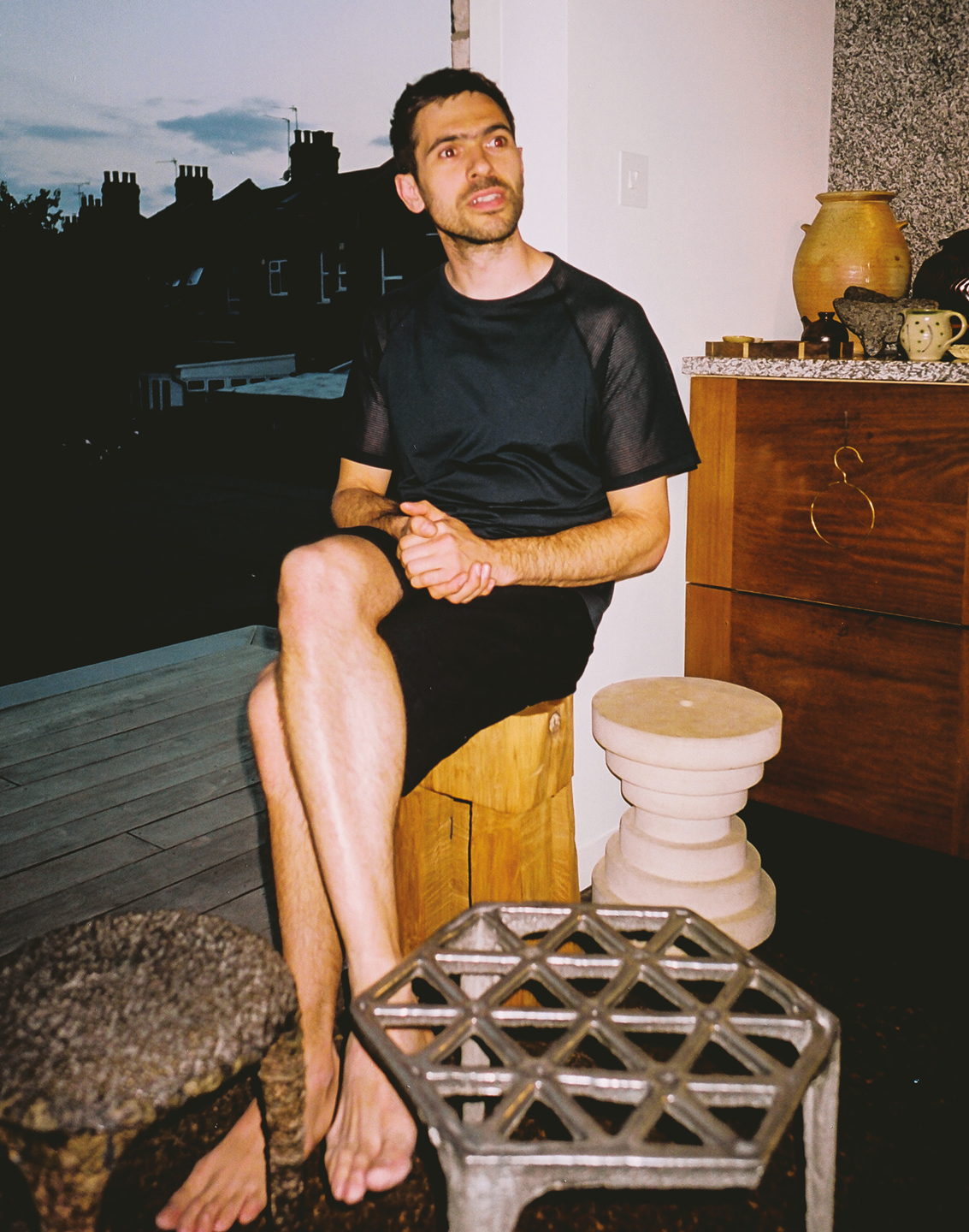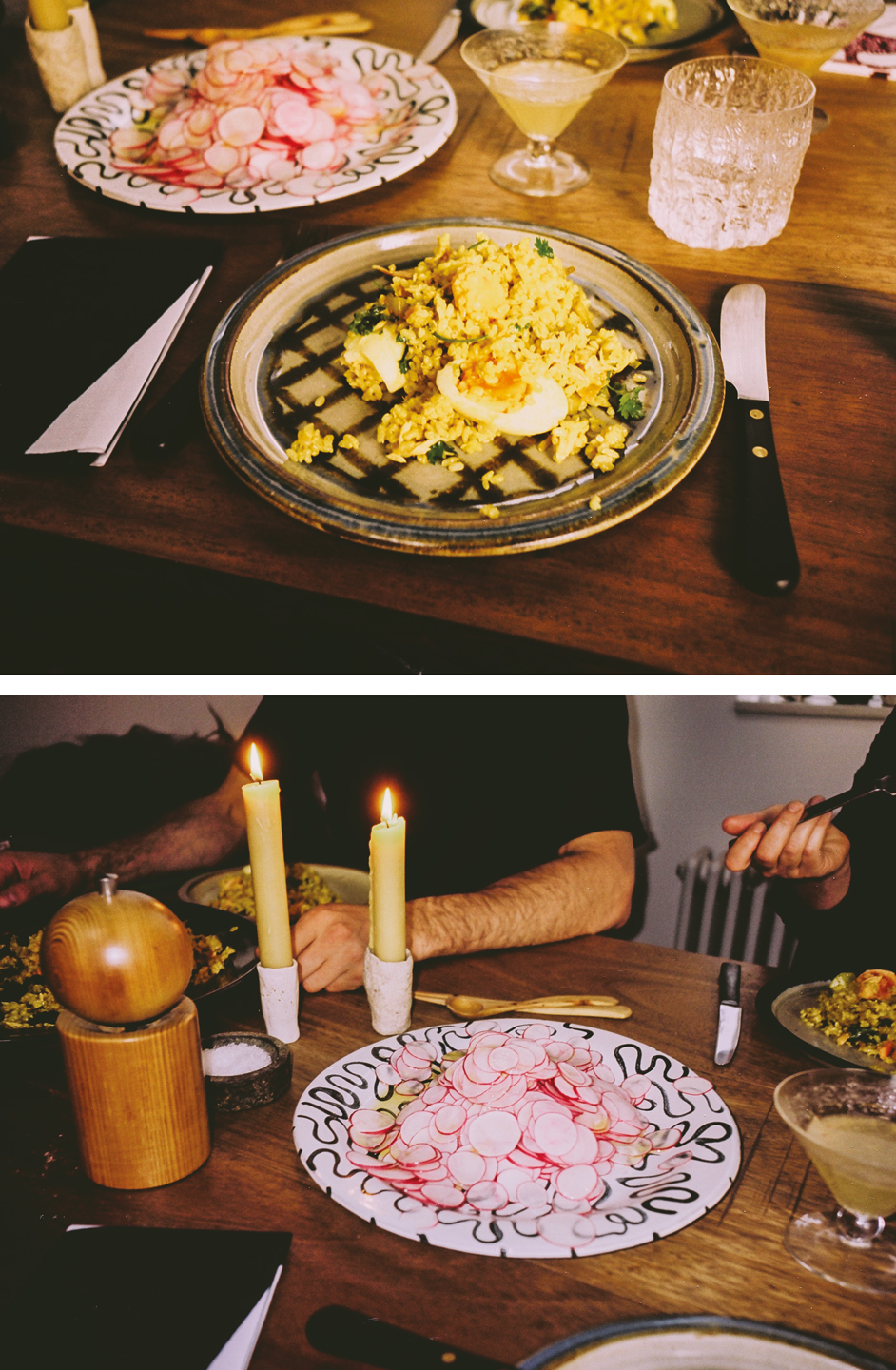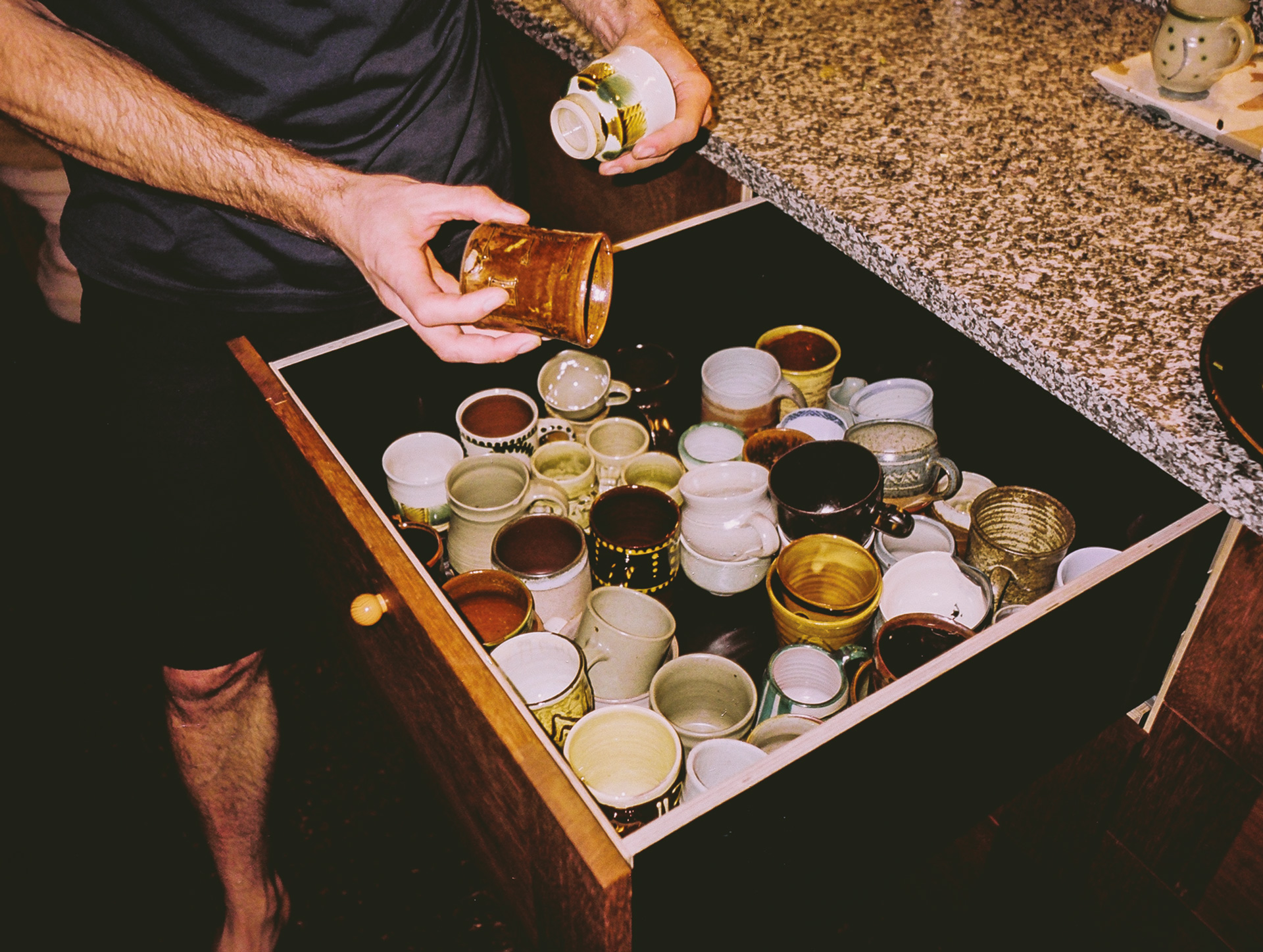Dinner with Max Lamb and Gemma Holt
At Max and Gemma’s place North London
Conversation with Rujana Rebernjak Photography Mehdi Lacoste

-
When I run into him at the opening of one of his exhibitions, he quickly bemoans those activities that seem to go hand in hand with design but don’t actually involve any actual designing. It is in that same spirit that he greets me at their house on the night of our scheduled dinner appointment: “Were it not for Gemma, who set this whole thing up, I would never have agreed to this interview in the first place.” If I were prone to hyperbole, I might say that Max speaks with the same sort of unmediated honesty that his work is often associated with.
-
Described in a myriad of different ways – ranging from “raw” to “primal” – Max’s work might be best defined as “process-based” design, led, ultimately, by his curiosity towards the history of man-made and, more specifically, hand-made objects, as well as by his intrinsic respect for the material and a desire to create pieces that are, above all, honest. His work demands a rigorous approach to research as it shifts the boundaries of processes commonly associated with specific materials. With an almost nomadic approach, Max travels between Japan and China, from Iceland to his native Cornwall, to produce objects that, without a certain understanding of the process that shaped them, might quickly be dismissed as simply ugly. That is precisely why documentation is vital to how his work is understood, and each exhibition that I visited during London Design Festival, was accompanied by long explanations and videos documenting the making of each piece. In fact, the documentation is equally or even more important than the object itself – it is the central aspect of each of his projects, without which they would not exist.
-
While Max has, in the past, designed objects that range from crockery to shelves, bars and shops, he uses chairs – that almost over-abused form of design experimentation – as the preferred medium for his research. Many of his chairs are safely guarded at the home he shares with Gemma. Set in an old warehouse, their home speaks the combined language of Max’s unmediated honesty and Gemma’s delicate, intimate precision. And, very similar to Max’s own work, it is an ongoing work–in-progress, perhaps an excuse, more than anything else, to always have something on their hands.
-
RRIt seems that, on top of your usual workload, this house has also been a serious project lately. Could you tell me a little bit about it – how did you find it in the first place?
-
GHWell, it took us three years to find it and get the permission needed to carry out all the work. Before we got it, this warehouse was actually a mosque, and you can still see a trace of its former use on a green door downstairs – where our studios are – that still needs to be replaced. Sometimes, people will come around looking for the mosque, unaware that it moved and the building was sold.
-
MLWhen we did all the work, our attempt was to be as truthful as possible to the origins of the building, while still taking our chances and working with materials that were close to my projects. It’s still very much a work in progress – as you can see from our temporary curtains. Actually, I’ve been working on that today, designing a particular system of ‘screens’ that will replace these pieces of paper that have been here for a while. Also, the kitchen table will be replaced with a new one that Martino Gamper is designing for us as a wedding gift. We got married when we bought the house.

-
RRSince you are both designers, what was the process behind designing the house? How did you agree on what to do, which materials to choose, apart from the furniture, which must have been quite an obvious choice…
-
MLWe have very different approaches to designing. Gemma is more focused on the details, while I always see the bigger picture. For example, when it came to the kitchen, I could imagine what it would look like when it was done, while Gemma, seeing only samples of different materials, couldn’t imagine the final result and needed a little bit of convincing. She has an amazing eye for details and great taste, so we complement each other very well.
-
GHWe were also aware of the endless options that we might have, so we tried to impose limits on ourselves, such as using only the materials that Max was working with at the time, or working with companies that have some sort of connection to this space. For example, all our taps come from a manufacturer that is based nearby.
-
RRIn fact, other than your furniture, I’ve noticed other bits and pieces of your work that have found their way to the house – like Marmoreal. And also, vice versa – while working on the house, you’ve incorporated some parts of it into your commissioned projects, such as the bar at the Ace Hotel here in London.
-
MLYes, the Marmoreal, a material that I developed from marble set in polyester resin, we used in our bathroom is actually the first version of the project, which has changed since. It’s a prototype, actually. The project for Ace Hotel, on the other hand, came about while we were doing the work on our roof. I decided to experiment with lead bashing and designed the bar working with that technique, but using zinc. I spend entire working days contacting different manufacturers. It is not as easy as it might seem to find companies that are open to the sort of work that I do, that will take on new ways of making things that differ from what they usually do. This is quite different to how I design, as I don’t work with a single medium, but often happily transition from being a wood-worker, to a metal-worker or a welder and so on.
I would almost say that the process is more important than the final result. It is the only way that I can communicate what I do.

-
RRIf we had to define your work, we might stay that you are a ‘process-based designer’. You work almost exclusively with small productions. How do you position yourself or ‘justify’ your work as a designer with respect to other types of design practice? Do you think design needs to be democratic?
-
MLWell, first of all, for me it is important that my work comes across as honest and humane. That’s why materials play such a huge part in my work. I place a lot of emphasis on the natural tendencies of the material I am using and let the material speak for itself. For example, take this Poly chair. It’s made of expanded polystyrene coated in rubber, and even though it is made of plastic, it’s imperfect, unlike this Joe Colombo chair for Kartell. It has this weird fleshy colour that makes it really humane, which I is really important to me when I make things. Making, on the other hand, means being in control of the process. I also enjoy knowing that I am making something unique for a person when I’m commissioned to produce a piece of furniture. I like to make objects for people. I often make a piece of furniture for a single person, hoping that it will fit within the context of that individual, the user. This is what makes the object valuable – to know that someone has made it specifically for that person and that all its imperfections and little details are unique. This is also why the process and its documentation are important in my work – the project is actually the documentation of the making process. I first started documenting my work extensively during my MA degree in Design Products at the Royal College of Art and I would almost say that the process is more important than the final result. It is the only way that I can communicate what I do, what is behind each finished product, which otherwise may not come across easily. Perhaps this is also why my designs are often described in weird, grotesque ways, because the process behind them is often overlooked. Yet, once you understand the making process behind each project, they become valuable in an unmaterialistic way.
-
RRWasn’t this also what you tried to point out with your glassware for Lobmeyr, exhibited in the recent “What is Luxury?” exhibition at the V&A?
-
MLYes, even though the glassware exhibited there does point out the relationship between monetary value, amount of work and the final object. It shows the luxury of making in a way, both in terms of cost and in terms of hours of work, as the engraving is the material representation of the time spent producing each piece, which is what would otherwise remain hidden.

-
RRYou mentioned that you studied at the RCA, I know that your recent exhibition in Milan, Exercises in Seating, started out as your graduate degree project…
-
MLYes, Exercises in Seating was my graduate degree project. I find the chair a really compelling object to work on. It is fairly straightforward, with a clear function that makes working with new materials or production techniques much easier. The exhibition in Milan was set in an old warehouse and I decided to arrange the chairs in a circle on the floor, so that they could be touched, not just looked at. Design is design, in the end, precisely because you have this direct relationship with objects - you can touch and use them.
-
RRCan you tell us anything about your future projects? What are you currently working on?
-
MLBesides a few private commissions, single objects that I am making myself, an interesting project that I’m working on is a series of stores for Opening Ceremony. After I designed their London pop-up at Ace Hotel, they asked me to work on their store-in-store at Nordstrom retailer in the US. It is a challenging project because I am working with a system that needs to be adapted for each individual space, some of which have quite complicated layouts. So, in a way, it is a system that needs to be reproduced with different variations.
-
RRYou two met while you were both studying at the Royal College of Art. Gemma, how did you decide to work as a designer and how would you describe your approach to design?
-
GHI first studied art in Manchester and then came to London where I studied Design Products. Martino Gamper was our tutor at the time, and I started working for him after graduation. Martino is actually making a jeweller’s bench for me, which I am really looking forward to. Even though I think he is worried that once I have the bench here I won’t be coming to the studio anymore. Anyhow, coming from an art background, at the beginning I didn’t know how to work with briefs, with the limits that are central to design practice. As Max said before, my approach is more detail-oriented, somewhere between art and design – neither functional nor solely oriented towards aesthetics. I would also say that, when posed with a problem or a limit, I tend to find the most obvious solution. Like these bracelets, for example, each of them takes the shape of the profile of the metal from which they are made. The one that is shaped like a D, has a d-shaped profile, the round one is a circle, and so on.
-
RRIsn’t that also a little bit ironic?
-
MLNo, Gemma is not at all ironic, that’s not her personality.
-
GHI would say it is obvious. To me, at least, making a d-shaped bracelet seemed like the most obvious solution.
Like these bracelets, for example, each of them takes the shape of the profile of the metal from which they are made. The one that is shaped like a D, has a d-shaped profile, the round one is a circle, and so on.

-
RRYou mentioned Martino being your tutor and now you work for him, did he play any influence as far as your excellent cooking is concerned? He is well-known for his cooking skills…
-
GHYes, I think I actually learned a lot just by being around him and watching him every day at the studio while he cooks. He and Frances, his wife, always have people around the studio, either for lunch or dinner. He is very generous with food, which is really nice.
-
RRMartino also exhibited your pottery collection at his show at the Serpentine Galleries last year.
-
MLYes, well I wouldn’t call it a collection. I would just say that we collect pottery, but it isn’t a collection. I’m originally from Cornwall and, over time, we’ve collected a lot of Bernard Leach’s pieces, who had a pottery in St. Ives. We also collect glass and Japanese lacquer. I am really amazed by the culture of craft in Japan, the level of craftsmanship and how the value of objects, the art of making, is recognised and appreciated.
-
RRThis is a silly question, but with Max working downstairs – with all the different materials he uses and his hands-on approach to designing – how do you actually keep the house clean, given that it’s actually pretty much an open space?
-
MLWell, I’ve learned a few tricks over time to keep my mess contained.
-
GHHe is not that bad, actually. But every once in a while I will find traces of different materials, perhaps months after he finished working on a project.
-
MLI like that, that somehow there are always traces of my work lingering around.